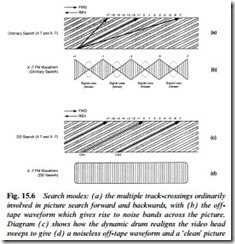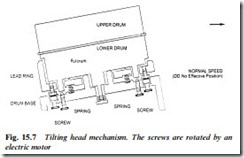MOTORS
For reliability and versatility it is common practice to provide direct- drive motors for head drum and capstan, in which the motor shaft carries the drum itself or forms the capstan respectively. These brush- less motors have built-in FG generators and a multi-pole drive stator, around which rotates a multi-pole magnetised ferrite disc or cup. A typical arrangement is shown in the circuit diagram of Fig. 15.8. The motor itself is on the right, and contains three main coils split
into six poles; an eight-pole rotating ring magnet; and three Hall ICs which are solid-state magnetic-field detectors. The drive circuit in IC2006 switches current into each coil in turn at 120° intervals. In this way, one coil-pair at a time will pull the ferrite disc round while a second coil-pair pushes it, the third being inactive. The sequence of coil-switching is controlled by the three rotor-position-sensing Hall ICs built into the stator assembly, and currents flow in both directions through the stator coils. To avoid flutter in motor speed due to any imbalance in coil currents or fields, the sampling resistor on pin 2 of IC2006 continually monitors motor current, passing in turn through all six coil halves. Any changes are compensated for by feedback to the torque control input at IC pin 20.
Motor control and switching is also carried out within IC2006. A speed control voltage (basically dependent on the error voltage from the servo circuit) enters on pin 15, where a falling potential will drive more current through the switching transistors and stator coils to accelerate the motor. Reverse, stop and forward commands from the system control block enter the IC on pin 11, where they are decoded in the motor rotation detection block.
A photograph of a direct-drive motor of this type appears in Fig.
This design is particularly flat and compact.

